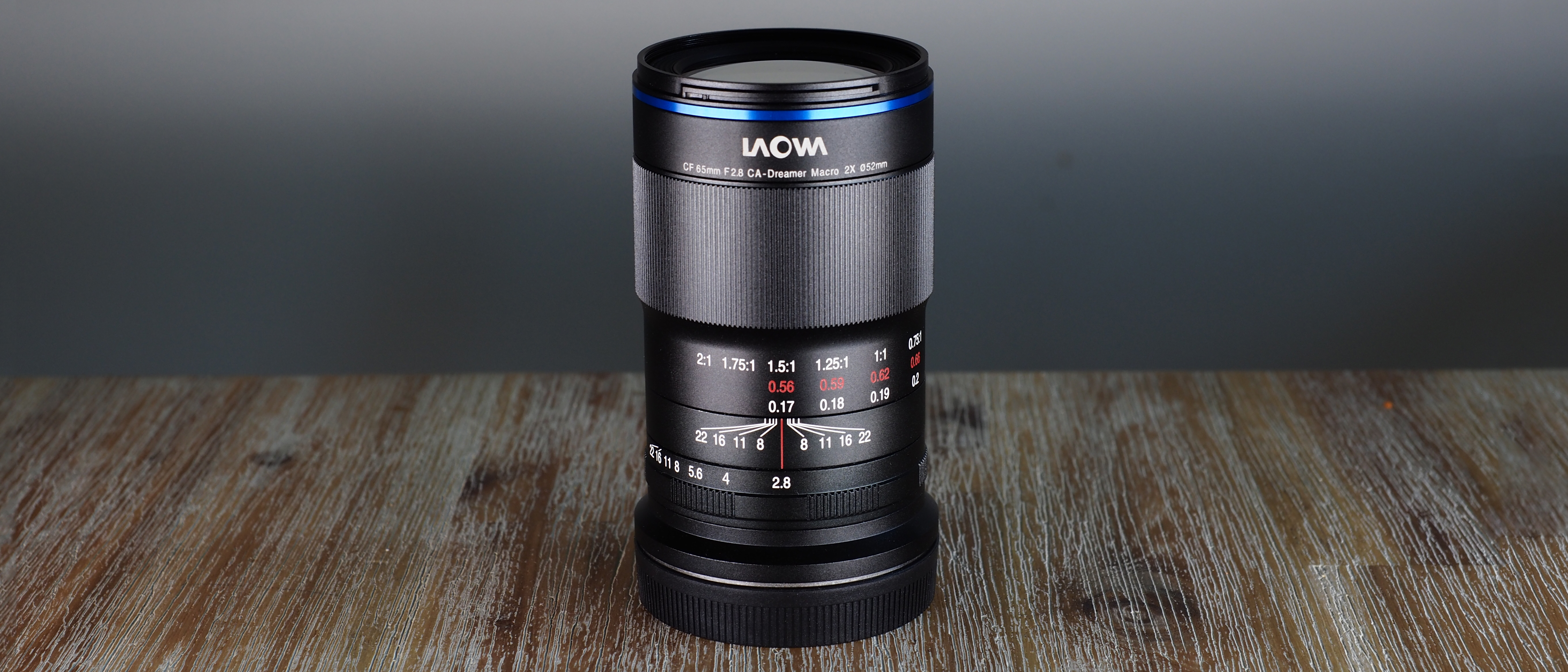Digital Camera World Verdict
The Laowa 65mm f/2.8 2x Ultra Macro APO is ludicrously sharp, especially for a lens at this price point. If you can live without luxuries like autofocus (not that macro users really need it), stabilization and EXIF data, there's absolutely no reason not to add this to your collection immediately – and even if you'd find those things hard to let go of, for this price there really is little to lose and whole lot to gain.
Pros
- +
Sharp as a Savile Row suit
- +
Focuses to infinity
- +
2x magnification
Cons
- -
No automatic /preset aperture
- -
No electronic contacts / EXIF
- -
No stabilization
Why you can trust Digital Camera World
Like many of the manufacturer's offerings, the Laowa 65mm f/2.8 2x Ultra Macro APO promises premium performance at a pocket-friendly price. Laowa has fast carved a niche for itself not just as a purveyor of exotic optics, but of expertly engineered ones that offer more than just quirkiness or lower cost of entry – and this is no exception.
Designed for APS-C systems using the Canon EF-M, Fujifilm X or Sony E mount, the Laowa 65mm Macro is among the best macro lenses in its own right. It's a rightful contender for our list of best Fujifilm lenses and is especially valuable for EOS M cameras, where it offers a rare native option for the likes of the Canon EOS M6 Mark II (which also has the high resolution to really take advantage of it).
Read more: 5 tips for choosing and using macro lenses
And, unlike most macro lenses you might pair or adapt to your compact APS-C body, this one is actually a size and weight befitting a smaller system…
Specifications
Mount: Canon EF-M (tested), Fujifilm X, Sony E
Lens construction: 14 elements in 10 groups
Angle of view: 24.4°
Diaphragm blades: 9
Minimum aperture: f/22
Minimum focusing distance: 0.17m (2x)
Maximum magnification ratio: 2:1
Filter size: 52mm
Dimensions: 57 (dia) x 100mm (length)
Weight: 335g
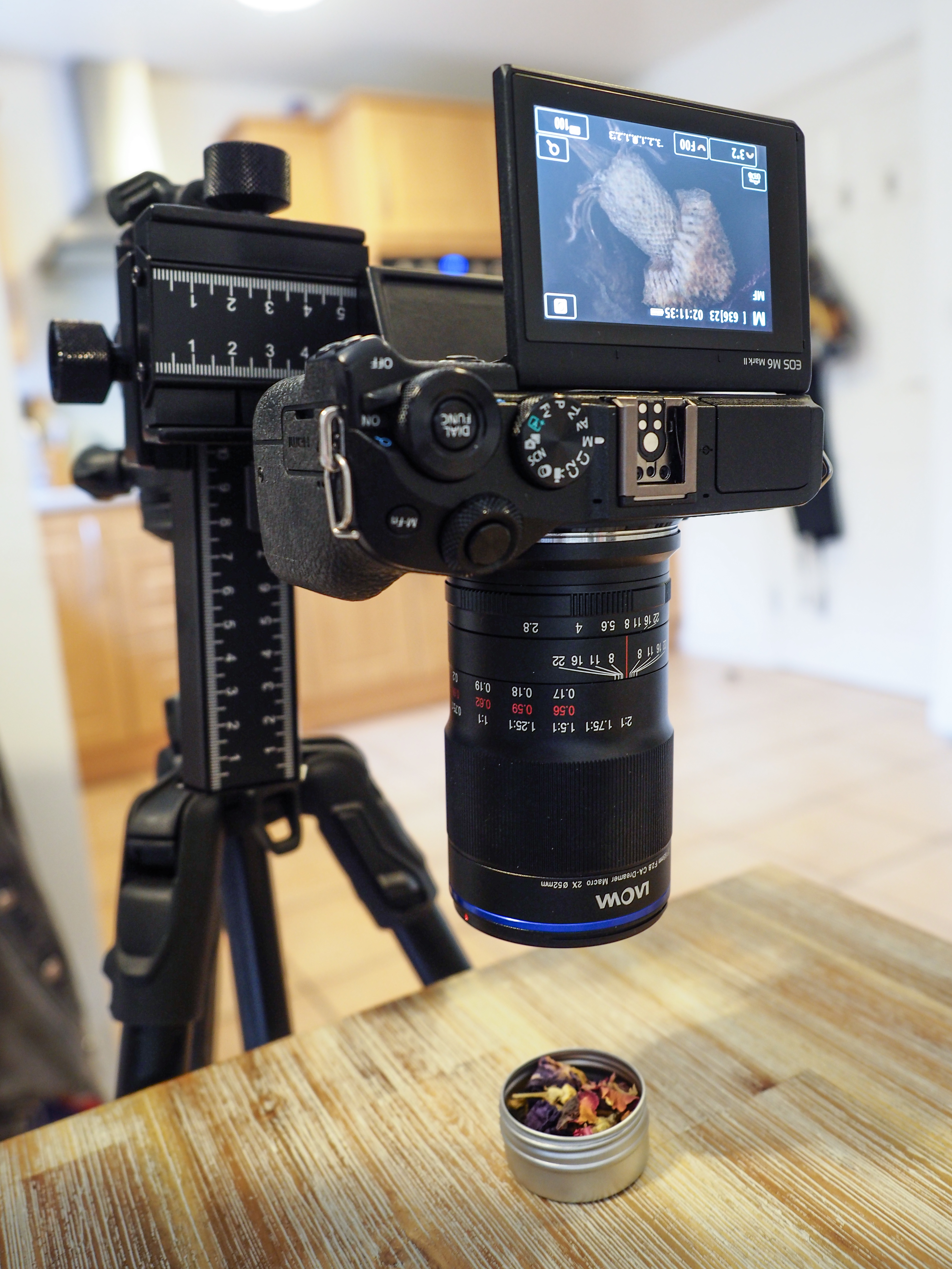
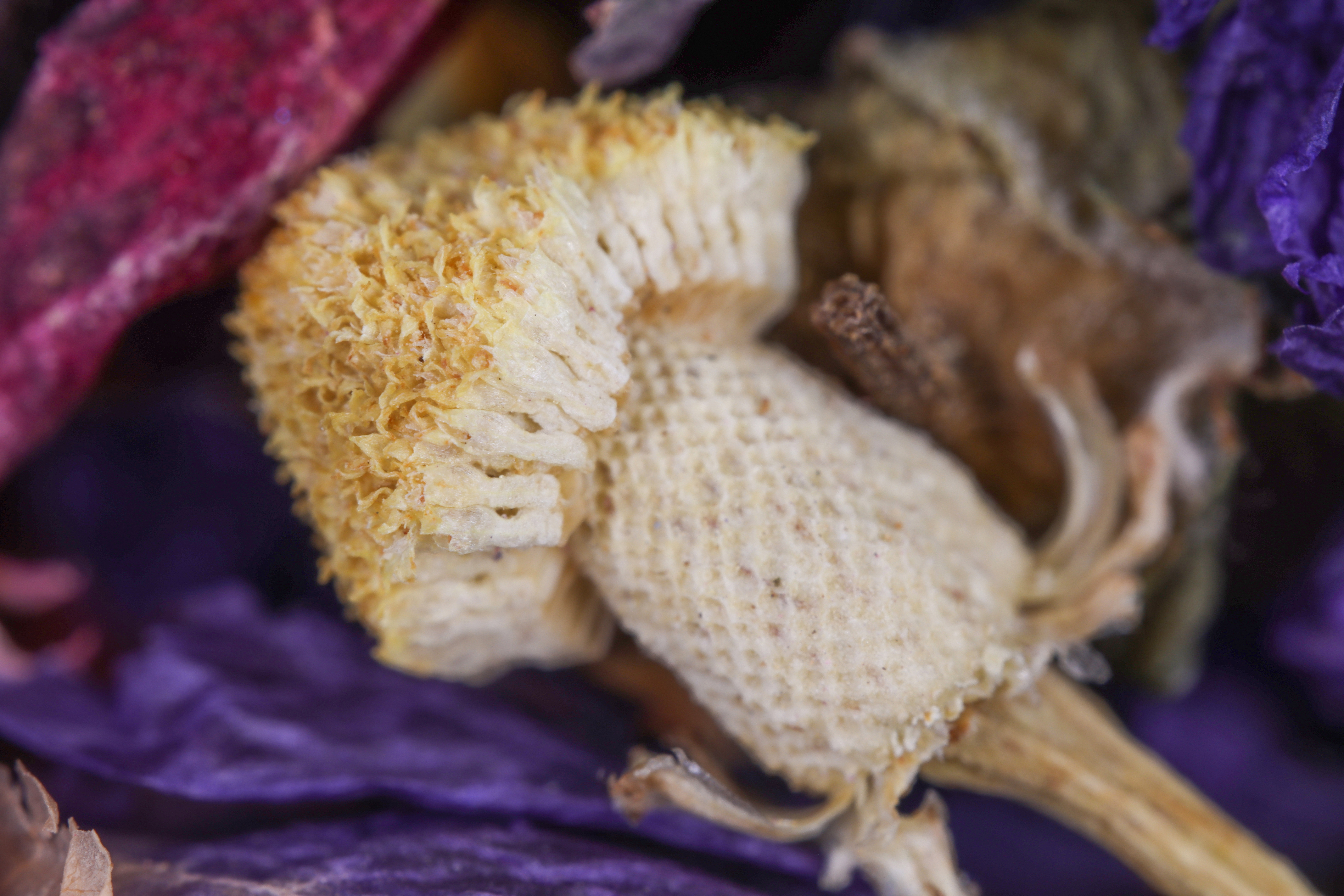
Key features
Obviously the signature feature of this lens is its 2x magnification feature, delivering a reproduction ratio of 2:1. If you're new to macro photography, that means that the image recorded on your sensor is double the life-size ratio of 1:1 (so if you take a photograph of a screw head, it will be double the actual size).
The ability to shoot at this kind of magnification is a dream for macro shooters, enabling you to turn even humdrum subjects into abstract miniature masterpieces. And, at the other end of the scale, you can also focus all the way to infinity – a rarity among macro lenses of this magnification.
Sharpness is quite stunning and, while Laowa doesn't bill it as one of its Zero-D lenses, this lens controls distortion magnificently.
Build and handling
The Laowa 65mm Macro is pleasingly solid, with robust all-metal construction. It's not weather sealed, but for this price you wouldn't expect it to be. The focusing mechanism is internal, so the lens doesn't telescope as you go from 0.5:1 to 2:1 – which both keeps the optic nice and compact, and prevents you from nudging your subject with an extending front element.
Speaking of compactness, this lens really is just that. It has a very thin barrel and isn't overlong at just 100mm – and crucially it's incredibly lightweight as well. All of this is important for an APS-C lens; yes, when you're shooting macro you're probably going to be using a tripod anyway, but we're always crestfallen when we have to mount gigantic DSLR-sized lenses on tiny mirrorless bodies. The Laowa 65mm has been deliberately designed for small systems, and the delicate footprint is most welcome.
The manual focus barrel is buttery smooth, with a lot of throw, giving you minute control over your image. The aperture ring is gently clicked, but still enables you to set it at in-between stops should you wish. However, something that is certainly missed is an automatic diaphragm or preset aperture.
This means that you need to manually open up and stop down the diaphragm to focus, which obviously makes using the lens handheld incredibly challenging – and isn't without peril if you're using a tripod that isn't 100% sturdy or is set up on soft flooring.
Speaking of handheld, while this is certainly an unfair ask of a lens at this price, the lack of stabilization means that you can pretty much forget about it unless you've got steadier hands than a surgeon!

Performance
This lens is very, very sharp. While our scrutinous lab testing revealed that sharpness drops off more than expected away from the center, in practice this wasn't a huge issue. Even shooting wide open the Laowa 65mm f/2.8 renders crystal clear images (in fact, it performs near optimally at the maximum aperture), reaching its peak at f/4 – though obviously working at these wide apertures, with this magnification, depth of field is still incredibly shallow, even with the APS-C crop mitigation.
Best results are achieved when shooting at f/4 and using focus stacking or focus bracketing, though you can safely stop down to about f/11 and use a longer shutter speed. However, bear in mind that – again at this magnification – even the most minute movement will be enough to throw your plane of focus. Make sure you shoot with an electronic shutter and set both your tripod and subject on the firmest surface possible.
If you are stopping down, even if only a couple of stops, again bear in mind that even the tiny movement caused by gently clicking the aperture ring can be enough to nudge your focus. An automatic diaphragm would really have helped in this situation, as you often need to open all the way up to get enough light to see what's in focus, though it's not insurmountable – most macro shooters will be acutely aware of the perils of shooting in these conditions!
The close working distance with this lens means that you will often be obscuring your light – so working in natural light, or even using conventional flashes or LEDs, can be a challenge. A ring flash that emits light around the barrel of your lens will be a valuable addition to your setup, if you don't already possess one.
Obviously the lack of electronic contacts means that there is no communication between camera and lens – which means, primarily, no EXIF data. This is no different to many other manual lenses, but clearly if you like to keep a track of things like f-stops you'll need to make a note as it won't be reflected in your image data.
If this is your first time using a macro lens, you will find it an absolute joy. Just remember to use your camera's focus peaking as a guideline, and then punch in with the magnify tool to make sure that what the camera thinks is sharp actually is sharp!

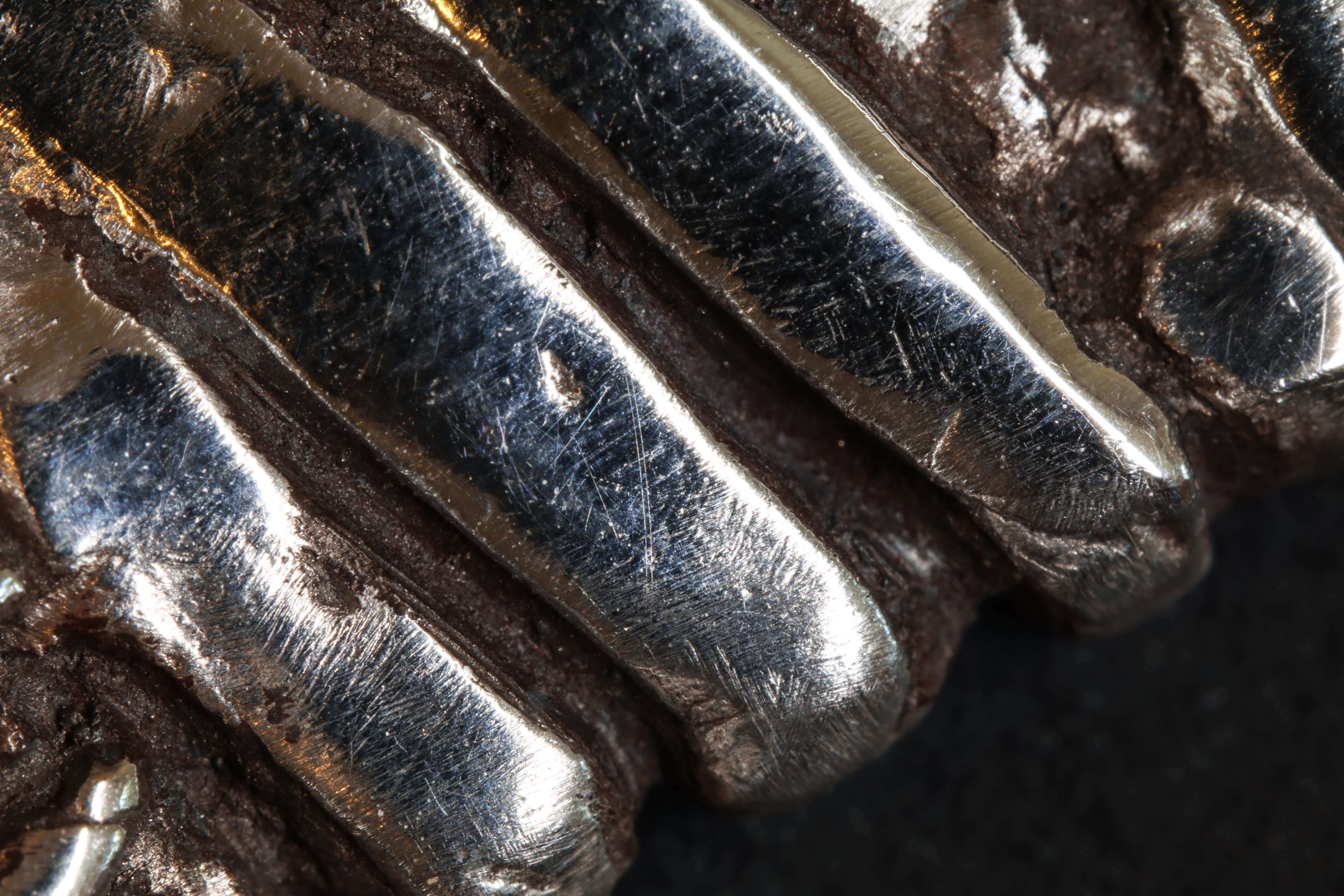
Lab data
We run a range of lab tests under controlled conditions, using the Imatest Master testing suite. Photos of test charts are taken across the range of apertures and zooms (where available), then analyzed for sharpness, distortion and chromatic aberrations.
We use Imatest SFR (spatial frequency response) charts and analysis software to plot lens resolution at the centre of the image frame, corners and mid-point distances, across the range of aperture settings and, with zoom lenses, at four different focal lengths. The tests also measure distortion and color fringing (chromatic aberration).
Sharpness
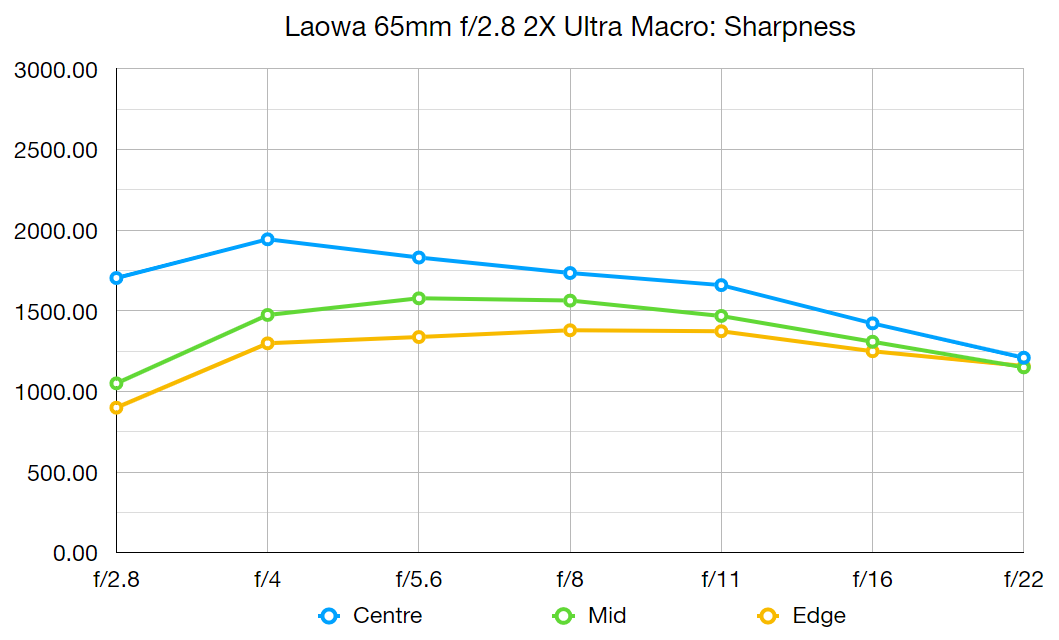
This test measures lens sharpness in terms of line widths per picture height. Any score exceeding 2,000 lw/ph is considered excellent. Centre-frame sharpness is very good wide open, through to f/11, peaking with an excellent score at f/4. Corner sharpness is more average, and we'd expect slightly higher results from a lens of this focal length, but the results are still commendable.
Fringing (lower scores are better)
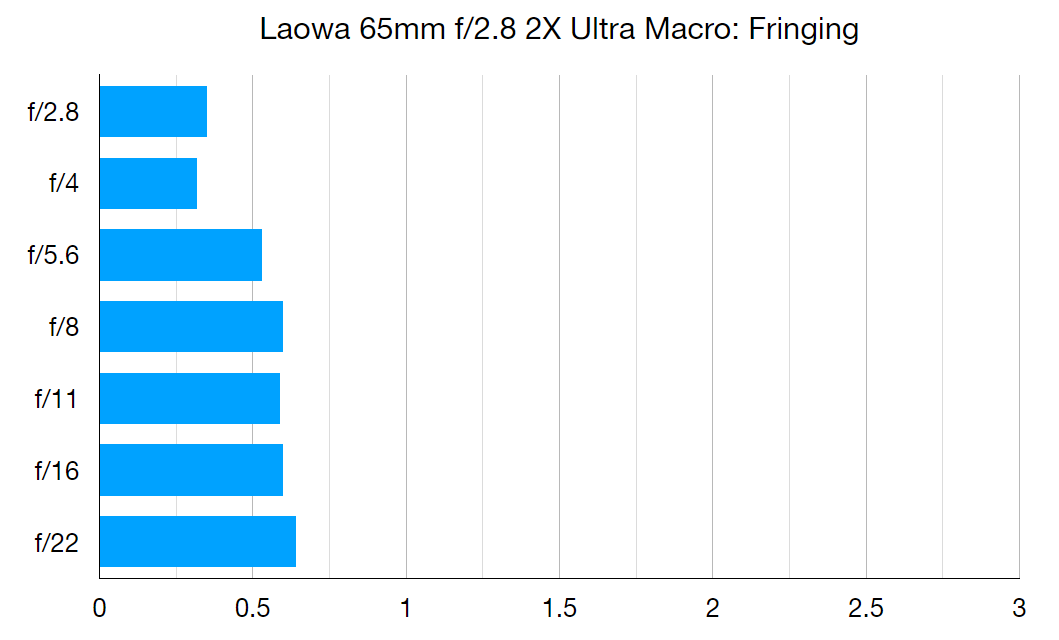
We measure fringing at the edges of frame, where it's likely to be most apparent. Chromatic aberration is very well controlled at all apertures. You'll be very unlikely to spot any fringing in real world shooting.
Distortion: 0.17
A figure of zero indicates a distortion-free lens. Although this isn't officially titled as one of Laowa's 'Zero-D' lenses, it may as well be, as the 65mm f/2.8 2x Ultra Macro produces practically no distortion - very impressive.
Verdict
The Laowa 65mm f/2.8 2x Ultra Macro APO is a great macro lens, and one that has been optimized for APS-C cameras. It's easy to use and delivers fantastic results, making it ideal for newcomers to macro shooting and seasoned hands alike.
Its lack of IBIS and automatic diaphragm means that handholding isn't something we'd recommend, though that's not typically why most people buy a macro lens anyway. Plonk your setup on a sturdy tripod and you'll achieve beautifully magnified photographs with an enviable 2:1 reproduction ratio – and the ability to focus to infinity makes the Laowa much more versatile than many dedicated macro lenses.
If you're looking to dip your toe into macro photography then this is the perfect place to start, as the cost of entry is very low. And if you're a veteran looking for your next macro lens, well, look no further.
Order the Laowa 65mm f/2.8 2x Ultra Macro APO from B&H
Read more:
The best macro lenses in 2020: get closer to your subjects than ever before!
Best ringflash for macro photography in 2020
Four macro photography ideas for budget-friendly shoots

James has 22 years experience as a journalist, serving as editor of Digital Camera World for 6 of them. He started working in the photography industry in 2014, product testing and shooting ad campaigns for Olympus, as well as clients like Aston Martin Racing, Elinchrom and L'Oréal. An Olympus / OM System, Canon and Hasselblad shooter, he has a wealth of knowledge on cameras of all makes – and he loves instant cameras, too.
